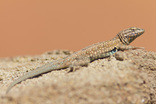The remaining crew spent the week in Fremont and Pueblo Counties, Colorado, during what is likely to be one of the last weeks some of the real heat-loving reptile species are active before entering hibernation. We expect to continue to see species including Prairie Rattlesnakes and Short-horned Lizards for at least 3 or 4 more weeks, but the prediction is that this winter is supposed to arrive early and temperatures are predicted to be much colder this year relative to last year...
| Celina - "Checkered Whiptails can be something of a frustration to me at times. Two incredibly similar looking species, both (almost) entirely female, thankfully they only have a small range overlap. Somehow I still have trouble keeping Colorado versus Common Checkered Whiptails straight. We found ourselves in Colorado Checkered Whiptail habitat this week, though we knew the adults would surely start slowing down and heading into hibernation soon as they prefer it hot, hot, hot. Despite that, we still saw a few, a large percentage of which were juveniles. The weather seems to be getting less consistent now, so this may have been one of our last chances to find this species for the season." | Beth - "We were afforded some days just hot enough to see a few Prairie Lizards, Colorado Checkered Whiptails, and a few more common snake species in the field this week. Often, when I'm surveying in southeastern Colorado and I walk into a site with junipers growing in gravelly soil I know I should be looking for Whiptails. However, when I found myself walking through a dry riverbed with Cottonwoods, I was not expecting to find a Colorado Checkered Whiptail juvenile! When I was able to snap a voucher photo and confirm that the little fleeting lizard I was looking at was actually a Whiptail, I realized I needed to expand future searches to include this habitat type. I have only seen adults of this species this summer and was happy to have the chance to see a juvenile. Even though we can feel the summer ending, it has been an unexpected joy to witness neonates and hatchlings - many look like miniatures of the adults we usually see." |
 RSS Feed
RSS Feed
